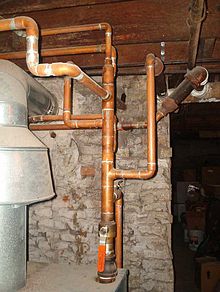Water pipe

Water pipes are pipes or tubes, frequently made of polyvinyl chloride (PVC/uPVC), ductile iron, polyethylene, or copper, that carry pressurized and treated fresh water to buildings (as part of a municipal water system), as well as inside the building.

For many centuries, lead was the favored material for water pipes, due to its malleability (this use was so common that the word "plumbing" derives from the Latin word for lead). This was a source of lead related health problems in the years before the health hazards of ingesting lead were fully understood; among these were stillbirth and high rates of infant mortality. Lead water pipes were still in common use in the early 20th century and remain in many households. Lead-tin alloy solder was commonly used to join copper pipes, but modern practice uses pure tin to join copper in order to eliminate lead hazards.
Wooden pipes were often used in Montreal and Boston in the 1800's. The pipes were hollowed out logs. These logs were tapered at the end with a small hole in which the water would pass through. The multiple pipes were then sealed together with hot animal fat.

Iron pipe was long a lower cost alternative to copper, before the advent of durable plastic materials but special non-conductive fittings must be used where transistions are to be made to other metalic pipes, except for terminal fittings, in order to avoid corrosion owing to electochemical reactions between dissimilar metals (see galvanic cell).
Bronze fittings and short pipe segments are commonly used in combination with various materials.
Pipe vs. Tube


The difference between pipe and tube is simply in the way it is sized. PVC pipe for plumbing applications and galvanized steel pipe for instance, are measured in IPS (iron pipe size). Copper tube, CPVC, PeX and other tubing is measured nominaly, which is basically an average diameter. These sizing schemes allow for universal adaptation of transitional fittings. For instance, 1/2" PeX tubing is the same size as 1/2" copper tubing. 1/2" PVC on the other hand is not the same size as 1/2" tubing, and therefor requires either a threaded male or female adapter to connect them.
Piping is available in rigid "joints", which come in various lengths depending on the material. Tubing, in particular copper, comes in rigid hard tempered "joints" or soft tempered (annealed) rolls. PeX and CPVC tubing also comes in rigid "joints" or flexible rolls. The temper of the copper, that is whether it is a rigid "joint" or flexible roll, does not affect the sizing.
The thicknesses of the water pipe and tube walls can vary. Pipe wall thickness is denoted by various schedules. Pipe wall thickness increases with schedule, and is available in schedules 20, 40, 80 and higher in special cases. The schedule is largely determined by the operating pressure of the system with higher pressures commanding greater thickness. Copper tubing is available in three wall thicknesses. Type 'M' (thinnest; typically only allowed as drain pipe by IPC code), Type 'L' (thicker, standard duty for water lines and water service), and Type 'K' (thickest, typically used underground between the main and the meter). Because piping and tubing are commodities, having a greater wall thickness implies higher initial cost. Thicker walled pipe generally implies greater durability and higher pressure tolerances.
Wall thickness does not affect pipe or tubing size. 1/2" L copper has the same outer diameter as 1/2" K or M copper. The same applies to pipe schedules. As a result, a slight increase in pressure losses is realized due to a decrease in flowpath as wall thickness is increased. In other words, 1 foot of 1/2" L copper has slightly less volume than 1 foot of 1/2 M copper.
Why Freezing Pipes Burst
Reduction of temperature wouldn't be a serious issue for water pipe, except for the contents of the pipe: water. Water is a substance that expands when solidified, so if water is sealed in a system (i.e. a pipe), the frozen water will expand in all directions it can. When it can go no further, meeting with valves, ice walls, or other such obstacles, the pressure of the unfrozen water begins to increase, as the same volume of water that freezes is now a larger volume of ice, reducing the available volume for the water. This increase in pressure ruptures the pipe at the weakest point within the frozen section, usually a section of pipe (as joints in pressure systems are designed to be stronger than the pipe). When the pipe ruptures, it becomes exposed to atmospheric pressure, and the difference in pressure, depending on the resistance of the ice, could result in flow of water through the breach, with the potential for significant property damage. If a recirculation line is in place, or if a fixture is left running, then freezing may not result in a breach of pipe, as moving water has a great deal more energy and a greater chance for heat exchange with a warmer environment than stationary water. The best case scenario when a pipe freezes and breaches is total freezing: no water flows because the freezing happened too quickly and too completely for the source to become exposed to any negative pressure difference. This is also seen when the weak point(s) is/are in a very cold area, and the source that remains above 0°C is far away. The water freezes as it falls, and seals the breach itself!
